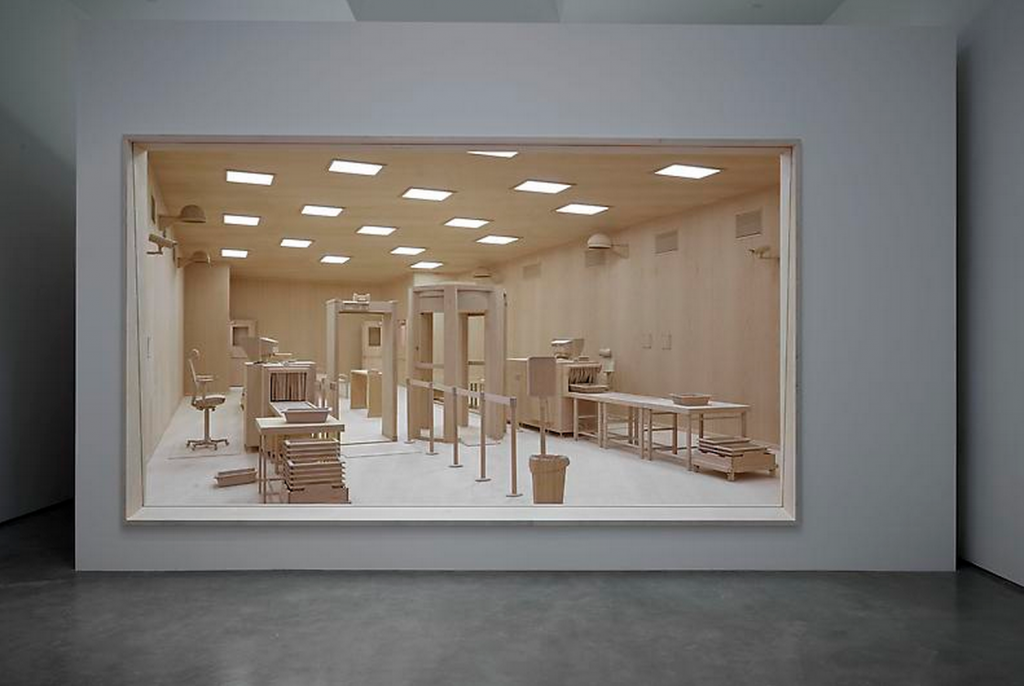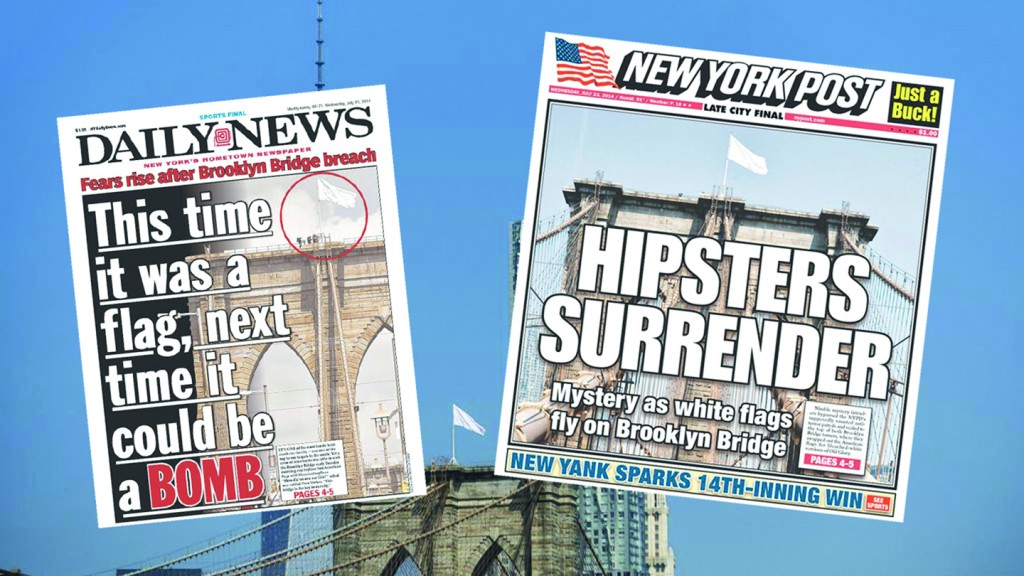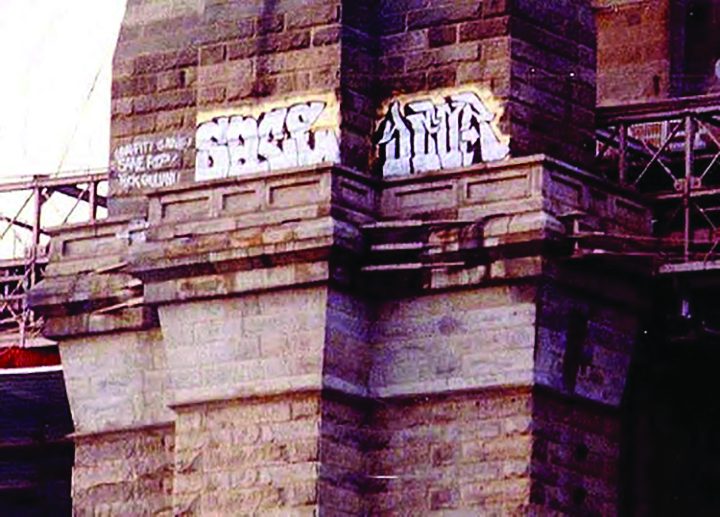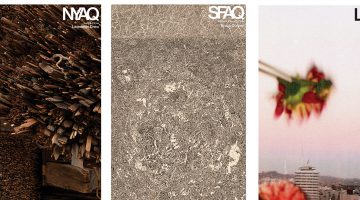While culture is in fact fluid and ever evolving, more hybrid than absolute, more transitional than determined, by our need to define and understand it we tend to ascribe those very terms of solidity and stasis that culture contradicts. Because we locate culture by place we presume it to be a set of destinations, and because we map changes in culture with a kind of historical linearity we also assume that culture is directional. Visual art does very well with determinate space—the monumental sculpture that comes to define the plaza it occupies and signify for its host city the site as a sight, the landscape that, for whatever poetic license it may take, will vest itself enough in the familiar to be about some place, the portrait that speaks to that person at that time, and the myriad genres from still life to history painting that all exercise some form of ontological premise. Even when art conjures enigma it still relies on specifics of space and time as context for content—Mona Lisa’s “smile” may continue to bewitch because it is betwixt, but its status has locality and venue in the mastery of Leonardo’s hand and the cultural temple of the Louvre. Much to that point, the kind of crossover fame that this painting has achieved is largely due to the spectacle of its temporary absence when it was stolen back in 1911, an event that made global headlines, stirred up international tensions, and drew mobs to the museum to gaze at the blank spot where the painting once hung.
As good as art is at making permanent the temporal, capturing for posterity the storm, the sunset, the glistening of morning dew, youth and beauty, or any of countless other fleeting moments we could cite in an index of clichés, it has considerable more difficulty when it depicts the interminable spaces of non-events by which time and life as we know it more frequently marches. It’s great at finding the spot, but it has trouble with what’s in between, and that’s not a failure of the medium by any means, it is rather the phenomenological dread we reserve for these interstices that make them so hard to behold. We expect art to take us somewhere, so we’re going to have a problem with it when it creates a kind of waiting room of persistent indeterminacy. Now, it’s become somewhat more debatable after the rush of modernism and the slippage of post-modernism whether art should deliver us what we want or decide what we need, but taking us someplace we don’t really consider being a place, or occupying that zone of intermediacy as if it were a legitimate place for creative expression, is pretty damn contrarian. You kind of want to just say “don’t go there,” but of course the problem with this kind of traumatic topography is that it’s less a there than a nowhere, a hypothetical composite of that pathological dis-ease we have between destinations in the insecurity of 21st-century terror.
Checkpoint of No Return
This map of places on the way—not the paths of travel that the arts have taken us on since Homer but the unremarkable way stations of tedium and boredom existing in between—is what occurred to me when I first considered Roxy Paine’s Checkpoint. At once a nowhere and an anywhere, Paine’s Checkpoint is a large-scale diorama of a TSA airport security checkpoint constructed entirely of unfinished maple and birch wood. From the trays in which you must put an ever-growing litany of personal effects and the conveyor belts that take them away to the scanners and screens by which the self surrenders to the surveillance of the State in a way that cannot help but feel like a virtual molestation, Checkpoint is almost pornographic in its exacting detail while dreamlike in its poetic transmogrification of its brutal terms into a kind of abstract formalism. Conjuring this realm of shame and scrutiny, where we are all forced to go when going somewhere but forbidden from going to when we are not, we are allowed both the perversity of voyeurism and the mortification of exile; encased behind glass, Checkpoint is even less a place as art than it is life. It is a diorama, perceptually like a two-dimensional representation of its three-dimensional space, the tease of thrill and fear embodied in the promise of the beyond and the threat of the barrier that is our airport experience made manifest in an installation in which proximity and impenetrability become an architecture of relative and irrelevant distances. And, as if this were not enough, it is all framed in a forced perspective that actualizes the constraints and constrictions it takes to navigate this space as a kind of optical affront. We look into the quintessential room without a view and see what—an event without action, drama without characters, a place without being there?

For whatever provocations Checkpoint may bring to mind, however, there is a certain archetypal anxiety contained in its emptiness, an inherent discomfort that would probably always be there to some extent but is magnified by the fears and curtailed freedoms of a post 9/11 world. That is, while there is a literal reading of this space and its function, which is unmistakable to all of us, there is also a kind of discreet psychological effect in this general type of space anyway. Let us call this place of transition, waiting, and not knowing Liminal Space, from the Latin limins for threshold, and know that for whatever positive or negative outcome at the end of its passage to be there is to suffer some disruption of the self. It is interesting to note here, too, that anthropologists have paid some attention to liminality in terms of ritual, defining that stage in the midst of a ritual as the liminal stage between the identity one begins with and the identity one ends up with and describing it as a point of ambiguity and disorientation. In a society such as ours today, where movement invokes both insecurity to the traveler and an implicit threat to the safety of the destination, we can see how such a commute has been ritualized to a point where the intermediate becomes a kind of collective fetish as if, like our most instinctual response to change, the threshold contains that sublime boundary between life and death.
If we are to seek out the liminal, we might easily do so by finding those social bottlenecks where we get held up between one place and another, and where most significantly that delay in passage becomes a kind of pregnant pause without resolution—rife with the implications of significance but ultimately most powerful precisely for an absence of absolute meaning. Psychologically it would seem to be a space of inquiry where secrets are kept close, physically it would be a space without geographical designation, and politically it would be a space where the laws of individual rights are waived for the expedience of some other measure. It’s not so easy to find the liminal in art because it’s not easy to manifest it there, but as this gray area of suspended logic continues to spread and permeate so much of our world, it is all the more vital for art to confront it.
Before we cite other examples by way of explanation, we might reconsider Checkpoint one last time in terms of where it was shown. Now this might be a pretty cheap shot, but it sure is worth considering the pedigree of Roxy Paine’s gallery. Marianne Boesky is an important gallery, what we would call blue chip for the number of major artists it represents. Without having the slightest idea of her relationship to her family, however, it strikes us as a pretty dubious flagship for contemporary art, because her father would be Ivan Boesky, one of a handful of truly evil players who have come to define the malignancy of laissez-faire capitalism in America. As a refresher, because his scandal is so long ago and maybe overshadowed by so many other equally vile economic transgressions, Boesky was the man who amassed one of the world’s greatest fortunes by the mid-eighties through the practice of corporate takeovers, which disassembled American industry to such a damaging degree that we are still feeling the effects today. He was convicted of insider trading and served a nominal sentence, greatly reduced because he turned informer as part of a plea deal with the Securities and Exchange Commission, which is to say on top of his myriad crimes he was, worst of all, a snitch. Frequently cited as the inspiration for the Gordon Gekko character in the movie Wall Street, it was Boesky who famously said, in a commencement speech in 1986 for the UC Berkeley Business School, “I think greed is healthy.” It is not, and he’s a perfect example of that, for greed is that thirst which cannot be slaked, a destination that gets exponentially distant as one moves towards it, so that it is forever liminal. Truth is that so much of the money that comes into the art world is so filthy in its origins we don’t want to look too closely at any of it, but what is relevant here is that Boesky was a master of liminality, working as an arbitrageur taking advantage of the price difference between two markets; that is, operating in the space in between.
A Bridge Too Far
We don’t look for liminal space, and often we consciously choose to look the other way. We just know it’s there. But when art turns its gaze upon it, the problematic and provocative nature of the subject inevitably incurs misunderstanding and even wrath. One of the most iconic of liminal landmarks in New York City is the Brooklyn Bridge. Though it represents a kind of tourist destination unto itself, its function as an intermediate between destinations complicates it. A monument and a motorway, the complexity of prosaic use and poetic properties has opened up the bridge to a beautiful ambivalence in the arts. It is here, in the operative metaphor of Hart Crane’s highly influential book The Bridge, where America is recast from its rural stasis into the urban reaching, that the urban art form of graffiti had its Alamo, and if America is to be understood as a land of punitive overreaction, the Brooklyn Bridge indeed deserves its hallowed place among our national symbols. Maybe it’s the ghosts of all the immigrant workers who died building the damn thing, but surely it is haunted by the infamy of tabloid exaggeration and cultural persecution. Its mythic stature in urban art dates to the story of Smith & Sane, adventurous and innovate graffiti writers who went afoul of authorities for conquering the bridge with a huge tag. When, then, is a bridge not a bridge? When it is a national landmark. It is by this logic that the crime of defacement became seen as a desecration, the status of historic site turning vandalism into a federal crime, the response so draconian and unrestrained that Sane’s subsequent death by falling from the bridge remains shrouded in mystery, with speculation ranging from suicide to murder.
With such a history, then, when artists return to the Brooklyn Bridge to situate self-expression on the social canvas of public space, they speak across a chasm far greater than that spanned by the bridge itself, their voices carrying with untoward amplification and undue distortion. Any conquest is rare and noteworthy, certainly so when famous art world bad boy Dash Snow got up not only his tag of Sace but a RIP tribute to Sane along with a “Fuck Guliani,” and particularly so this past summer when the huge United States flag that flies from the tower of the bridge was removed and replaced by one that had been painted over in white. The hue and cry was so great you would have thought that someone bombed the Statue of Liberty, and indeed bombing was the implication. Fighting yet another made-up war without borders or any other real sense of definition, the War on Terror has inspired in us a fear greater than all the mutant genes, crack babies, and psychedelic homicides of the War on Drugs, and posited all that dread within the interstices of travel. Considered at first a terrorist attack, when such hyperbole couldn’t sustain itself morphing into a shocking lapse of security, the furor latched onto the event without consideration of what it might mean. Was this the white flag of surrender or the bleaching of American authority? Was it a desecration of the flag or of the bridge, and was this attack merely symbolic or deeply visceral? The absence of apparent purpose, and worse that defining silence where we might hear the voice of some bogeyman, made it disturbing in its pointlessness, lost like a Malaysian airliner.

I’ve often found over the years that if people get really upset about something they can’t understand, you can tell them “it’s art” and they stop worrying so much. It becomes an explanation in and of itself, all the better because people are used to not understanding art. This of course proved true for the flag on the bridge. Once we learned that it was the work of two German street artists, Mischa Leinkauf and Matthias Wermke, it seemed (in the public eye at least) less an outright molestation than a fair warning about protecting our bridges, guarding our flags, and, well, staying very afraid of terrorists. The hack art writer from the NY Times to whom the artists eventually spoke, taking authorship over their work by way of confession, thought he was being clever by comparing the work to Jasper Johns’s seminal White Flag of 1955, which after all lives in NYC. The artists had some other reasoning, so quirky and beautifully beside the point that it had to be the truth, about paying homage to the German engineer John Augustus Roebling who was responsible for the construction of the Brooklyn Bridge. As someone who has been a fan of these artists for some time now, let me offer another context: street art, occupying that thin membrane of urban topography where private property meets public space, is predicated on interface and most prominent at the intersections.
Some artists, Leinkauf and Wermke in particular, have understood this inherent intermediacy of their practice and played with these spaces in between or to the side with hilarious effect. More social than political as artists, their gestures are visual pranks, interventions in the quotidian that poke fun of our reality. On an earlier trip they had attacked the Brooklyn Bridge previously, but as that piece involved balloons it just didn’t have the gravitas of a defaced flag to raise the hackles of panic. That kind of gesture—minimal, non-invasive, and momentary—is at the heart of their praxis. Masters of the liminal, their art works best at a sidelong glance, the subway train in the station, conductor and passengers alike perplexed as “workmen” arrive with squeegee and bucket to clean the window, or their own DIY transport, riding the subway rails on their own handcar. Stepping into the transitional, the boundaries and thresholds of liminal space, art prods and tickles us where and when we least expect it allowing for questions and doubts to flourish in the breach between certainties.



